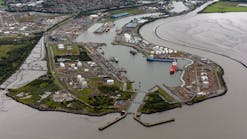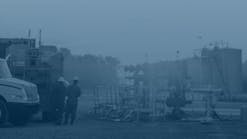G. Alan PetzetOperators expect to complete several hundred wells to Cretaceous Fort Union coals this year in the northeastern Powder River basin.
Exploration Editor
Favorable price and purchaser conditions and workable environmental restrictions have spawned a low cost play that has produced nearly 500 intents to drill since mid-1995.
Western Gas Resources Inc., Denver, said the Powder River basin coals were delivering about 28 MMcfd of methane at yearend 1996. This is up from about 10 MMcfd a year ago and only about 1 MMcfd in 1991.
Another 35 MMcfd is shut-in waiting on connection and pipeline hookup. The coal is in a 40-90 ft seam 150-600 ft deep.
About 240 Fort Union wells are on production in the greater Gillette area of Campbell County, Wyo. Drilling is just starting in Big Horn and Rosebud counties, Mont.
All drilling to date has been within 10-12 miles of and downdip from about 18 large open pits from which sub-bituminous Fort Union coals have been mined. None of the coal companies captures or owns any gas.
The dominant operators in the play are Western Gas Resources Inc. and Redstone Resources Inc., both of Denver, who have leased about 80% of the known play area in Wyoming. A half dozen others have smaller positions.
Western's position
Western plans to start up five new compressors this year that will handle 25 MMcfd, bringing total coal seam volumes on its MIGC Inc. interstate pipeline unit to more than 70 MMcfd by yearend.
It is starting up the last of four compressors comprising 4,800 hp installed since third quarter 1996. These four units serve about 19 MMcfd of output from previously completed wells.
Western has acquired the rights to develop coal seam gas on about 120,000 acres in two areas, Mills-Gillette north of Gillette, and Durham Ranch adjacent to Western's Hilight gas plant in the greater Lighthouse project area.
Initial production was established in both areas in December 1996. Western plans to drill 105 wells this year, which it said are expected to result in about 32 bcf of gas reserves at a development cost of about 25¢/Mcf. Ultimately, Western anticipates production from at least 250 company operated wells to exceed 32 MMcfd during a 5 year development schedule.
Western estimated that within the next 5 years, Powder River basin gas production from all operators could reach as high as 150 MMcfd from 600-1,000 new wells. This will require more than 50,000 hp of compression and modifications to MIGC.
Low well costs
Operators were receiving around $4/Mcf for the methane during January 1997, but the price can wither to little more than $1 in warmer months.
Because of the shallow coal depth, one operator figures he spends about $35,000/well, including drill- ing, completion, and gathering costs. Water well rigs can drill one Fort Union well per day.
Federal tax credits have no part in the present play, although a few early wells were completed before it expired.
Proximity to the coal mines may have reduced the amount of water operators must pump off.
Western Gas was the only purchaser until KN Energy began buying recently. KN's entry improved prices at the wellhead, and more purchasers are expected to become interested.
Operators spent nearly a year with government and environmental people working out how to remove water and put it to beneficial use in the arid area.
Understanding coals
The trend where drilling has occurred is about two townships wide by seven townships northwest-southeast near the basin's northeastern rim.
The coal was long thought not to have been buried deep enough to have generated much thermogenic methane, but the gas turns out to be largely biogenic; that is, created by bacterial action on the coal.
One exploration technique to locate positive structural features is to drill an expendable well every 40 acres. This costs about $2,000/well.
Early production wells drilled by Martens & Peck, Denver, have produced 200 Mcfd/well for 5 years with little decline.
The Fort Union coals are buried about 2,500 ft at the basin's center, but costs of lifting and handling water sour present economics when the coal is buried 800 ft or more, Redstone president Eric Szaloczi said.
Dry gas wells (naturally dewatered) have been drilled on the tops of structures. When in the water, wells yield 5-20 gpm.
Tending the wells
Coal company aquifer monitoring wells that were producing several hundred thousand cubic feet per day of methane after tens of years are one factor that led methane operators into this play.
Initial wells were drilled with techniques borrowed from other U.S. coalbed methane basins. Wells were drilled, cased, perforated, and given frac jobs.
Today rigs working for Redstone drill and set casing on two wells per day, then underream the coal to 12 in., circulate, install a downhole electric water pump, and produce water up tubing and gas through the annulus and out insulated wellheads.
Estimated ultimate recoveries are unkown, but present estimates are 300-400 MMcf/well.
Redstone's wells average a 300 Mcfd initial production rate, but this has ranged as high as 1.2 MMcfd. Redstone hopes to drill about 150 wells in 1997, raising its yearend production capacity fivefold to about 100 MMcfd.
Formation pressure is 80 psi at about 250 ft, so gathering systems are needed to keep the wells on vacuum or at no more than about 5 psi at the wellhead. Four stage compression is needed to boost gas into sales lines.
Most of the existing gathering systems in the area were built to handle 1,300 BTU casinghead gas.
Redstone has been in the play about 11/2 years. By mid-January it had drilled 70 wells, 40 of which were on production. And during January it had laid 140,000 ft of 4 in. plastic gathering pipe.
Scope of the play
The play is getting off the ground in Montana and has a solid foothold in Wyoming.
Energx Ltd., Riverton, Wyo., in late 1995 permitted seven Fort Union exploratory locations in 9s-39e, 40e, and 41e in Big Horn County, Mont.
Field names in the play in Wyoming include Caballo, Ranchhouse, Marquiss, Mill, Maysdorf, Haight, Meadowlark, Lynde, and Rawhide Butte.
The area of existing development extends from about 46n to 53n and across parts of 71w to 73w, roughly centered on the city of Gillette.
Other companies with coalbed methane operations in the play include Citation Oil & Gas and Torch Operating Inc. of Houston, Duncan Oil Inc., Denver, and DCD Inc., Gillette. Working with Redstone is Coenergy Rockies, an affiliate of MCN Corp., Detroit.
Copyright 1997 Oil & Gas Journal. All Rights Reserved.


